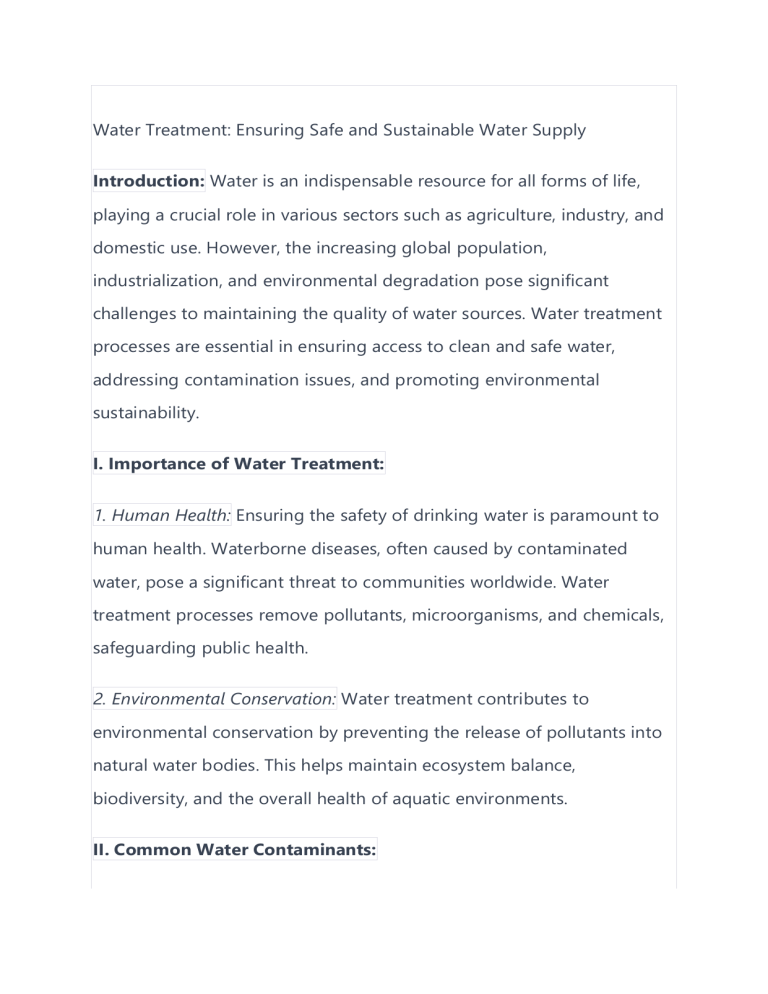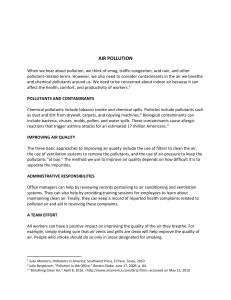
Water Treatment: Ensuring Safe and Sustainable Water Supply Introduction: Water is an indispensable resource for all forms of life, playing a crucial role in various sectors such as agriculture, industry, and domestic use. However, the increasing global population, industrialization, and environmental degradation pose significant challenges to maintaining the quality of water sources. Water treatment processes are essential in ensuring access to clean and safe water, addressing contamination issues, and promoting environmental sustainability. I. Importance of Water Treatment: 1. Human Health: Ensuring the safety of drinking water is paramount to human health. Waterborne diseases, often caused by contaminated water, pose a significant threat to communities worldwide. Water treatment processes remove pollutants, microorganisms, and chemicals, safeguarding public health. 2. Environmental Conservation: Water treatment contributes to environmental conservation by preventing the release of pollutants into natural water bodies. This helps maintain ecosystem balance, biodiversity, and the overall health of aquatic environments. II. Common Water Contaminants: 1. Microorganisms: Bacteria, viruses, and parasites are common waterborne pathogens that can cause diseases such as cholera and dysentery. Water treatment involves disinfection methods like chlorination and UV irradiation to eliminate these microorganisms. 2. Chemical Pollutants: Industrial discharges, agricultural runoff, and improper waste disposal introduce chemicals like heavy metals and pesticides into water sources. Water treatment utilizes processes like coagulation, filtration, and adsorption to remove these contaminants. 3. Nutrients: Excessive nutrients, such as nitrogen and phosphorus, can lead to water eutrophication, causing algal blooms and depleting oxygen levels. Water treatment plants implement biological processes to control nutrient levels and maintain water quality. III. Water Treatment Processes: 1. Coagulation and Flocculation: This initial step involves adding coagulants to water, forming small particles that attract impurities. Flocculation promotes the aggregation of these particles, facilitating their removal. 2. Sedimentation: In sedimentation tanks, floc settles to the bottom, separating from the water. This process removes larger particles and impurities. 3. Filtration: Water passes through layers of sand, gravel, or other media to capture remaining suspended particles. Filtration is a crucial step in removing fine particles and enhancing water clarity. 4. Disinfection: To eliminate remaining microorganisms, water treatment plants use disinfection methods such as chlorination, UV irradiation, or ozonation. These processes ensure the microbiological safety of the treated water. 5. Desalination: In regions facing water scarcity, desalination processes like reverse osmosis or distillation are employed to remove salt and make seawater suitable for drinking and irrigation. IV. Advanced Water Treatment Technologies: 1. Membrane Filtration: Membrane technologies, including reverse osmosis and ultrafiltration, offer efficient removal of contaminants at the molecular level, ensuring high-quality water. 2. Advanced Oxidation Processes (AOPs): AOPs utilize powerful oxidants like ozone and hydrogen peroxide to break down persistent organic pollutants, providing an effective solution for treating industrial wastewater. 3. Nanotechnology: Nanomaterials and nanocomposites show promise in water treatment due to their enhanced adsorption capabilities and the ability to target specific contaminants. V. Challenges in Water Treatment: 1. Emerging Contaminants: The identification and removal of emerging contaminants, such as pharmaceuticals and endocrine-disrupting compounds, pose challenges as these substances may not be effectively treated by traditional methods. 2. Climate Change Impact: Climate change affects water availability and quality, leading to increased instances of extreme weather events. Water treatment infrastructure must adapt to these changes to ensure resilience. 3. Aging Infrastructure: Many water treatment plants globally face challenges associated with aging infrastructure, requiring substantial investments for upgrades and modernization. VI. Case Studies: 1. Singapore's NEWater: Singapore's innovative approach to water treatment, including NEWater production (purified recycled water), showcases the importance of technological advancements in achieving water sustainability. 2. The Rhine River Basin: Efforts to rehabilitate the Rhine River demonstrate successful collaborative initiatives between countries to address historical pollution and restore water quality. VII. Future Trends and Innovations: 1. Smart Water Management: Integration of digital technologies, such as IoT sensors and data analytics, facilitates real-time monitoring and management of water treatment processes. 2. Green Infrastructure: Natural and sustainable solutions, like green roofs and permeable pavements, contribute to stormwater management and reduce the burden on traditional water treatment systems. Conclusion: Water treatment is a fundamental component of ensuring a safe and sustainable water supply for current and future generations. As challenges evolve, continuous research, innovation, and international collaboration will be crucial in developing effective solutions to address water quality issues worldwide. By prioritizing water treatment and embracing emerging technologies, societies can safeguard public health, protect the environment, and secure a resilient water future.





